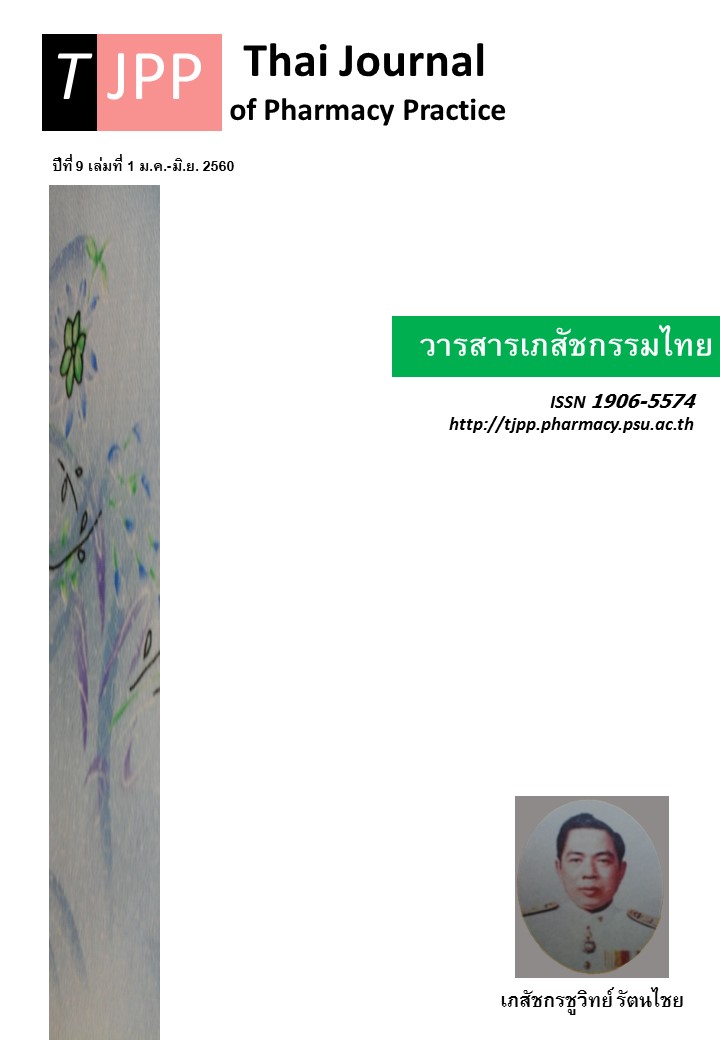การบริบาลทางเภสัชกรรมและจ่ายยาต่อเนื่องสำหรับ ผู้ป่วยเบาหวานประเภทที่ 2 ในร้านยามหาวิทยาลัย
Main Article Content
บทคัดย่อ
วัตถุประสงค์: เพื่อเปรียบเทียบผลลัพธ์การบริบาลทางเภสัชกรรมและจ่ายยาต่อเนื่องที่ร้านยากับการรับบริการที่โรงพยาบาล วิธีการ: การศึกษาเป็นการวิจัยแบบกึ่งทดลอง กลุ่มตัวอย่างคือ ผู้ป่วยเบาหวานชนิดที่ 2 ที่มารับบริการที่คลินิกผู้ป่วยนอกของโรงพยาบาลขนาด 444 เตียงแห่งหนึ่ง ตัวอย่างเป็นผู้เลือกเองว่าจะร่วมการวิจัยในกลุ่มทดลองหรือกลุ่มควบคุม กลุ่มทดลองจำนวน 59 คน ได้รับการบริบาลทางเภสัชกรรมและรับยาต่อเนื่องที่ร้านยาโดยเภสัชกร กลุ่มควบคุมจำนวน 59 คน ได้รับบริการตามปกติที่คลินิกพิเศษของโรงพยาบาล การศึกษาประเมินผลลัพธ์ทางคลินิก (HbA1C, BUN, and serum creatinine) ผลลัพธ์ทางเศรษฐศาสตร์ (ค่าใช้จ่ายด้านยา) และผลลัพธ์ทางมานุษยวิทยา (คุณภาพชีวิต) ก่อนและหลังการแทรกแซง 1 ปี การศึกษาประเมินคุณภาพชีวิตด้วยแบบวัด SF-36 ผลการวิจัย: เมื่อสิ้นสุดงานวิจัยเหลือผู้เข้าร่วมวิจัยกลุ่มละ 32 คน เนื่องจากตัวอย่างย้ายไปรับบริการที่สถานีอนามัยใกล้บ้าน ย้ายภูมิลำเนา หรือถูกส่งกลับไปรักษาที่โรงพยาบาล ลักษณะพื้นฐานของผู้ป่วยทั้งสองกลุ่มก่อนการทดลอง ไม่มีความแตกต่างอย่างมีนัยสำคัญทางสถิติในด้านเพศ ระยะเวลาที่เป็นเบาหวาน สถานภาพสมรส และโรคประจำตัว แต่อายุและระดับการศึกษามีความแตกต่างกันอย่างมีนัยสำคัญทางสถิติ หลังการทดลองพบว่า กลุ่มทดลองมีค่า HbA1C ต่ำกว่ากลุ่มควบคุมอย่างมีนัยสำคัญทางสถิติ BUN ไม่แตกต่างกันทั้งสองกลุ่ม ค่า serum creatinine ในกลุ่มทดลองน้อยกว่ากลุ่มควบคุมอย่างมีนัยสำคัญทางสถิติ ผลประเมินคุณภาพชีวิตพบว่า การรับรู้สุขภาพทั่วไปของกลุ่มทดลองดีขึ้นกว่ากลุ่มควบคุมอย่างมีนัยสำคัญทางสถิติ ด้านค่าใช้จ่ายด้านยา พบว่า กลุ่มทดลองมีค่าใช้จ่ายด้านยาน้อยกว่า และมีจำนวนครั้งที่พบเภสัชกรมากกว่ากลุ่มควบคุม สรุป: ผลการวิจัยแสดงให้เห็นว่า การให้บริบาลทางเภสัชกรรมและจ่ายยาต่อเนื่องโดยเภสัชกรในร้านยาช่วยให้ผู้ป่วยเบาหวานประเภทที่ 2 มีผลลัพธ์ทางคลินิกและคุณภาพชีวิตที่ดีขึ้น นอกจากนี้ยังช่วยประหยัดค่าใช้จ่ายทางด้านยาอีกด้วย การบริบาลทางเภสัชกรรมและจ่ายยาต่อเนื่องในร้านยาโดยเภสัชกรจึงเป็นทางเลือกหนึ่งของผู้ป่วยเบาหวานในการมารับบริการในอนาคต
Article Details
ผลการวิจัยและความคิดเห็นที่ปรากฏในบทความถือเป็นความคิดเห็นและอยู่ในความรับผิดชอบของผู้นิพนธ์ มิใช่ความเห็นหรือความรับผิดชอบของกองบรรณาธิการ หรือคณะเภสัชศาสตร์ มหาวิทยาลัยสงขลานครินทร์ ทั้งนี้ไม่รวมความผิดพลาดอันเกิดจากการพิมพ์ บทความที่ได้รับการเผยแพร่โดยวารสารเภสัชกรรมไทยถือเป็นสิทธิ์ของวารสารฯ
เอกสารอ้างอิง
/files/idf_atlas_2015_uk_0.pdf.
2. Tonghong A. Annual epidemiological surveillance report 2012. Bangkok: Bureau of Epidemiology, Thailand, 2012.
3. Division of Strategy and Planning, Bureau of Non Communicable Disease. Annual report in 2015. Bangkok: Department of Disease Control, 2016.
4. Bureau of Strategy and Planning, Office of Permanent Secretary of Ministry of Public Health. Database on individual inpatient in universal coverage scheme and civil servants medical benefit scheme. 2013.
5. Bernsten C, Bjorkman I, Caramona M, Crealey G, Frokjaer B, Grundberger E, et al. Improving the well-being of elderly patients via community pharmacy-based provision of pharmaceutical care: a multicentre study in seven European countries. Drugs Aging. 2001;18:63-77.
6. Chen JH, Ou HT, Lin TC, Lai EC, Kao YH. Pharmaceutical care of elderly patients with poorly controlled type 2 diabetes mellitus: a randomized controlled trial. Int J Clin Pharm. 2016;38:88-95.
7. Chung WW, Chua SS, Lai PS, Chan SP. Effects of a pharmaceutical care model on medication adherence and glycemic control of people with type 2 diabetes. Patient Prefer Adherence. 2014; 8: 1185-94.
8. Edwards HD, Webb RD, Scheid DC, Britton ML, Armor BL. A pharmacist visit improves diabetes standards in a patient-centered medical home (PCMH). Am J Med Qual. 2012;27:529-34.
9. Kelly C. Implementation and evaluation of a pharmacist-managed diabetes service. J Manag Care Pharm. 2000;6:488-93.
10. Ko JJ, Lu J, Rascati K, Stock EM, Juan J, Suh K, et al. Analysis of glycemic control of a pharmacist-led medication management program in patients with type 2 diabetes. J Manag Care Spec Pharm. 2016;22:32-7.
11. Mourao AO, Ferreira WR, Martins MA, Reis AM, Carrillo MR, Guimaraes AG, et al. Pharmaceutical care program for type 2 diabetes patients in Brazil: a randomised controlled trial. Int J Clin Pharm. 2013; 35: 79-86.
12. Wishah RA, Al-Khawaldeh OA, Albsoul AM. Impact of pharmaceutical care interventions on glycemic control and other health-related clinical outcomes in patients with type 2 diabetes: randomized controlled trial. Diabetes Metab Syndr. 2015;9:271-6.
13. Xin C, Ge X, Yang X, Lin M, Jiang C, Xia Z. The impact of pharmaceutical care on improving outcomes in patients with type 2 diabetes mellitus from China: a pre- and post-intervention study. Int J Clin Pharm. 2014; 36:963-8.
14. Xin C, Ge X, Zheng L, Huang P. Evaluation of pharmaceutical care in a diabetes ward from China: a pre-and post-intervention study. Int J Clin Pharm. 2016;38:34-40.
15. Rugpao S. Methodology and statistics in clinical research. Chiang Mai, Thailand: The promotion of medical texbook project of the Faculty of Medicine, Chiang Mai University; 1996.
16. Leurmarnkul W, Meetam P. Development of a quality of life questionnaire : SF-36 (Thai version) Thai Journal of Pharmaceutical Science. 2000; 24 : 92-111.
17. Davidson MB, Karlan VJ, Hair TL. Effect of a pharmacist-managed diabetes care program in a free medical clinic. Am J Med Qual. 2000;15:137-42.


